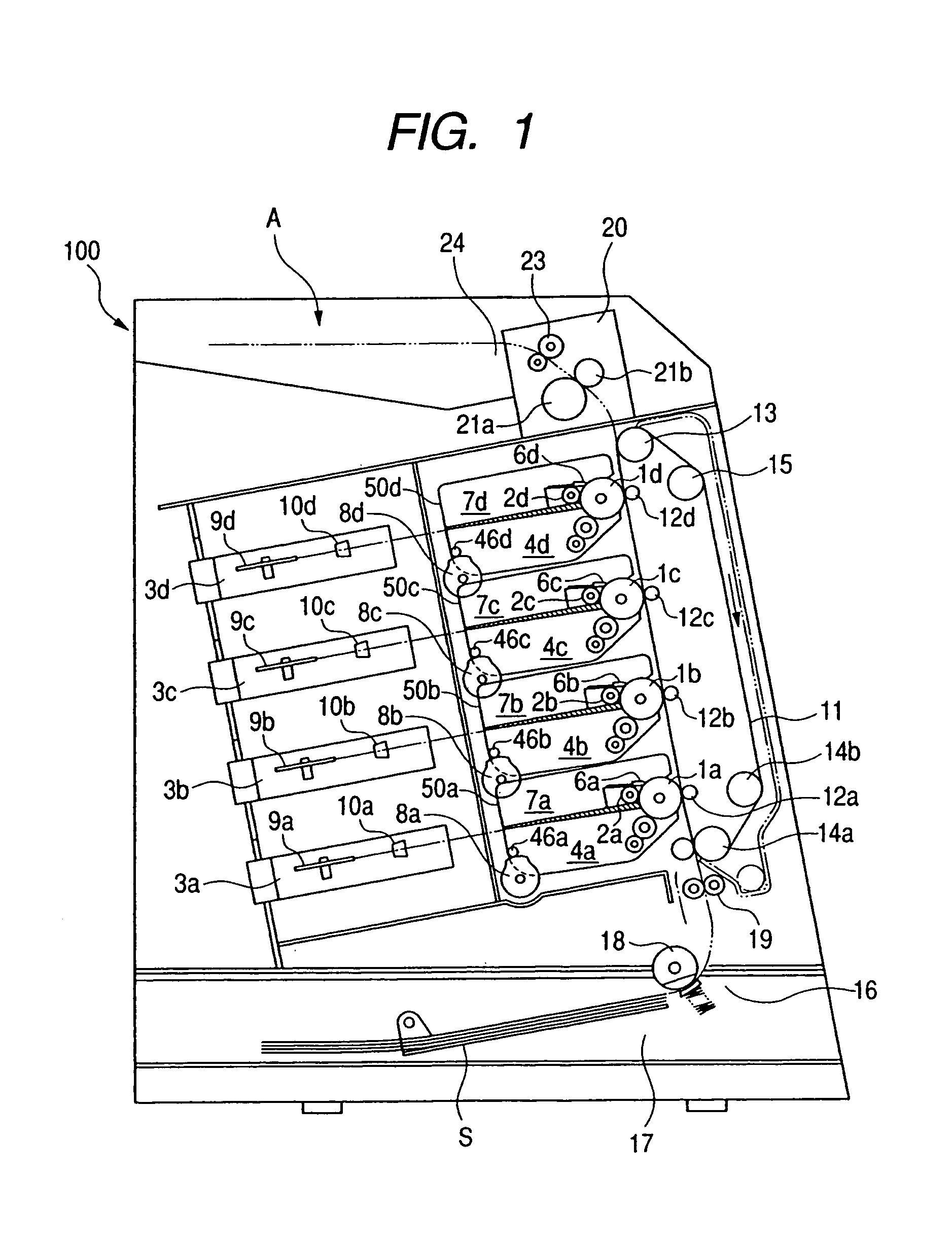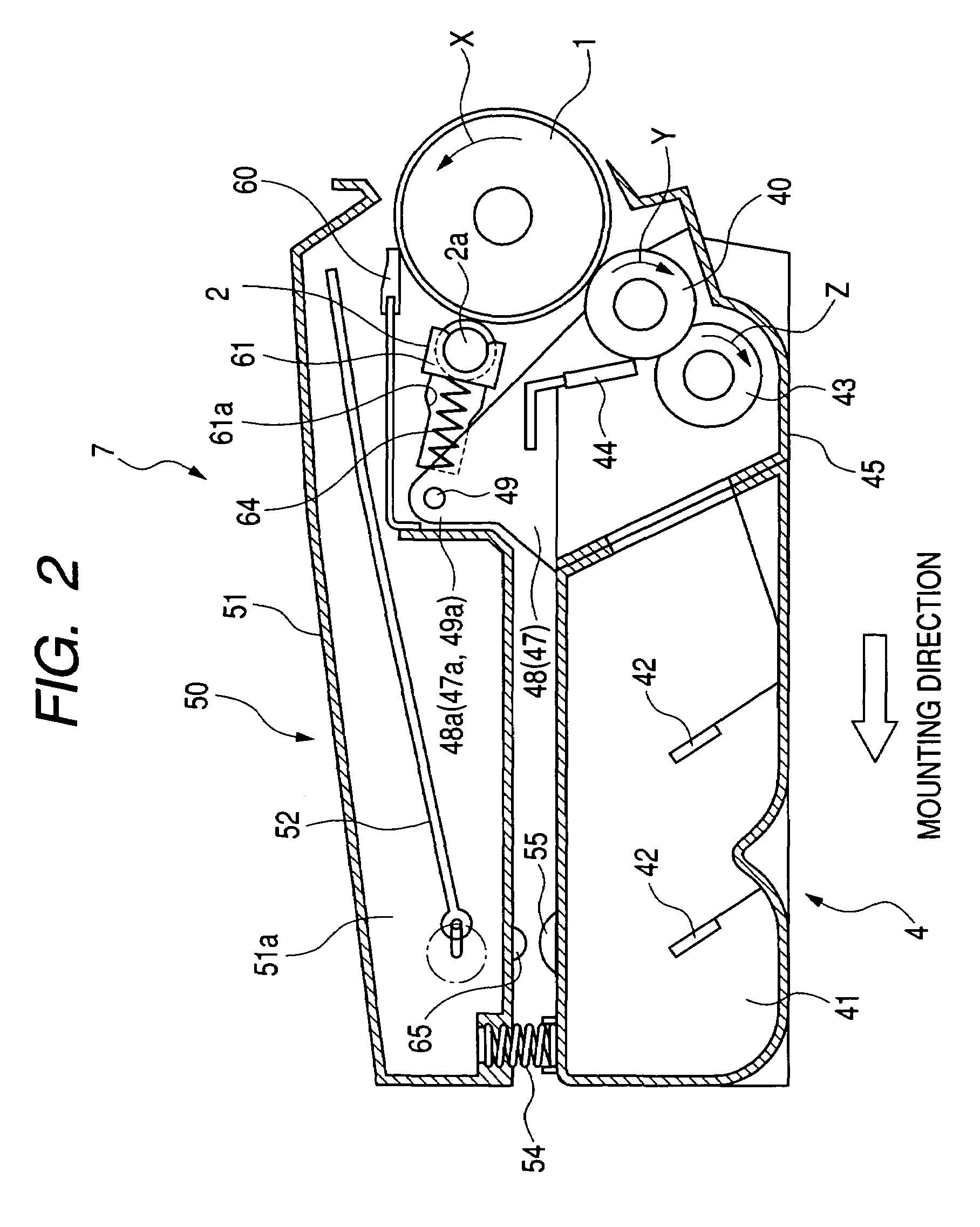Process cartridge and electrophotographic image forming apparatus
a technology of electrophotographic image and process cartridge, which is applied in the direction of electrographic process apparatus, corona discharge, instruments, etc., can solve the problems of high voltage power source, image unevenness, ozone generation, etc., and achieves no unevenness, simple construction, and cost-saving process cartridge
- Summary
- Abstract
- Description
- Claims
- Application Information
AI Technical Summary
Benefits of technology
Problems solved by technology
Method used
Image
Examples
embodiment 1
[0033]FIG. 1 is a diagram showing the general construction of a color electrophotographic image forming apparatus according to an embodiment of the present invention, FIG. 2 is an explanatory sectional view of a process cartridge, and FIG. 3 is a perspective view showing how the components of the process cartridge are put together.
(General Construction of the Image Forming Apparatus)
[0034]First, the general construction of an image forming apparatus will be described with reference to FIG. 1. An image forming apparatus 100, shown in FIG. 1, has four process cartridge attachment portions arranged side by side in the vertical direction, with each attachment portion having a developing roller separating means (8a, 8b, 8c, 8d) constituting a separating means. Then, each of cartridges 7 (7a, 7b, 7c, 7d) respectively attached to the attachment portions is equipped with a drum-like electrophotographic photosensitive member serving as an image bearing member, that is, a photosensitive drum ...
embodiment 2
[0096]In the image forming apparatus main body of Embodiment 1 described above, the cams 80 acting on the process cartridge 7 are of a three-stage construction, thereby making it possible for the developing unit 40 to assume three swinging attitudes. This makes it possible to selectively realize three states with respect to the photosensitive drum 1:
[0097](1) the state in which both the developing roller 40 and the charging roller 2 are in contact with it (first swinging attitude);
[0098](2) the state in which only the developing roller 40 is separated from it (second swinging attitude); and
[0099](3) the state in which both the developing roller 40 and the charging roller 2 are separated from it (third swinging attitude).
[0100]However, when, for example, the hardness of the elastic rubber layer of the charging roller 2 is low to some degree, the elastic rubber layer does not easily undergo permanent deformation to involve problems regarding image formation even if the process cartrid...
embodiment 3
[0103]While in Embodiment 1 described above, there are provided in the first unit, that is, the photosensitive member unit 50, the links 58 and the cranks 57 as the charging member releasing means, the same effect can be achieved by some other construction. Another embodiment of the charging member releasing means will be described with reference to FIGS. 14 and 15.
[0104]First, one end of a wire 67 is connected to either end of the charging roller 2. The other end of each wire 67 is connected to a connecting portion 68 provided at the rear end portion of the cleaning frame 51. The wires 67 are stretched with slight slackening to a degree such that the charging roller 2 is not separated from the photosensitive drum 1 due to variation in dimensional tolerance. Here, inside the cleaning frame 51, there is provided a rib 69 for regulating the wires 67. The distal end 69a of the rib 69 extends up to the vicinity of a straight line connecting the center of the charging roller 2 and the co...
PUM
 Login to View More
Login to View More Abstract
Description
Claims
Application Information
 Login to View More
Login to View More - R&D
- Intellectual Property
- Life Sciences
- Materials
- Tech Scout
- Unparalleled Data Quality
- Higher Quality Content
- 60% Fewer Hallucinations
Browse by: Latest US Patents, China's latest patents, Technical Efficacy Thesaurus, Application Domain, Technology Topic, Popular Technical Reports.
© 2025 PatSnap. All rights reserved.Legal|Privacy policy|Modern Slavery Act Transparency Statement|Sitemap|About US| Contact US: help@patsnap.com



